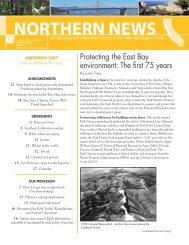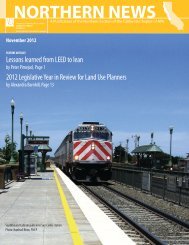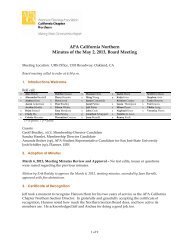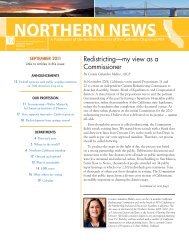Layout 1 - Northern California Chapter of the American Planning ...
Layout 1 - Northern California Chapter of the American Planning ...
Layout 1 - Northern California Chapter of the American Planning ...
Create successful ePaper yourself
Turn your PDF publications into a flip-book with our unique Google optimized e-Paper software.
Shared Equity models <strong>of</strong>fer sustainable homeownership (continued from previous page)rates to first-time homebuyers earning no more than100 percent <strong>of</strong> AMI.More than 850 Below Market program units —most <strong>of</strong> <strong>the</strong>m condominiums — are in <strong>the</strong> city’s portfolio.These units are overseen by <strong>the</strong> Housing Office, whichalso administers <strong>the</strong> Residential Inclusionary AffordableHousing Program. The department posts information onbelow-market units available for purchase on its websiteand requires developers to advertise <strong>the</strong> units in at leastfive local newspapers that reach low- and moderateincomeand minority households in <strong>the</strong> city.Income-eligible buyers are required to participate in afirst-time homebuyer workshop conducted by designatedhousing counseling agencies. These agencies receiveCDBG funds from <strong>the</strong> city to promote homeownershipcounseling and build capacity in minority communities.Buyers must finance <strong>the</strong>ir purchase through 15- to40-year fixed-rate mortgages from approved lenders.Housing Office staff members review <strong>the</strong> mortgagesto make sure that buyers are not subjected to predatorylending practices.For both new and resale units, buyers are chosen bypublic lottery from a pool <strong>of</strong> qualified applicants. TheHousing Office <strong>of</strong>fers prospective homeowners assistancewith down payment and closing costs ranging from$10,000 to $36,000. The funds are structured as sharedappreciation loans to be repaid by <strong>the</strong> homeowner at<strong>the</strong> time <strong>of</strong> resale along with a certain percentage <strong>of</strong><strong>the</strong> property’s price appreciation; <strong>the</strong> amount <strong>of</strong> homevalue appreciation to be shared with <strong>the</strong> city dependson <strong>the</strong> portion <strong>of</strong> <strong>the</strong> original purchase price coveredby <strong>the</strong> loan.Long-term affordabilityTo protect <strong>the</strong> long-term affordability <strong>of</strong> below-marketunits, resale restrictions are recorded with <strong>the</strong> propertydeed; purchasers sign a secondary deed <strong>of</strong> trust andrelated documents acknowledging <strong>the</strong> restrictions.Such restrictions or covenants are a widely usedmechanism to preserve affordability. Hundreds <strong>of</strong>jurisdictions across <strong>the</strong> country employ deed restrictionsto impose controls on affordable housing units producedthrough inclusionary zoning, and many CLTs use <strong>the</strong>min lieu <strong>of</strong> long-term ground leases, particularly forcondominium developments.Unlike a CLT ground lease, however, <strong>the</strong> length<strong>of</strong> <strong>the</strong> affordability period in deed-restricted housingprograms can vary depending on state statutes. Somestates specify a limit to <strong>the</strong> affordability period, while veryfew explicitly define or authorize perpetual affordabilityrestrictions. The restrictions placed on San Francisco’sbelow-market units are applicable for <strong>the</strong> life <strong>of</strong> <strong>the</strong>project and survive foreclosure; for units that werecreated before June 2007, <strong>the</strong> restrictions apply for50 years but restart every time a unit is sold. The units,which must be owner-occupied at all times, can be passedto heirs only if <strong>the</strong> heirs meet all <strong>of</strong> <strong>the</strong> program qualifications(income-eligible, first-time homebuyer).The Housing Office monitors compliance by requiringbelow-market owners to submit an annual occupancycertification and report any changes in ownership status.The <strong>of</strong>fice also reserves <strong>the</strong> right <strong>of</strong> first refusal topurchase below-market units listed for resale.A balancing actIn 2007, <strong>the</strong> city revised its homeownership program inresponse to changing market conditions. Previously, <strong>the</strong>resale price for below-market units was based on one <strong>of</strong>two formulas: changes to <strong>the</strong> consumer price index or amortgage-based formula.The latter formula calculates <strong>the</strong> resale price byarriving at a mortgage payment that is affordable(defined as no more than 33 percent <strong>of</strong> gross income)to a household earning 100 percent <strong>of</strong> AMI. Along with a10-percent down payment, <strong>the</strong> formula takes into accountinterest rates, taxes, homeowners association fees, andinsurance costs at <strong>the</strong> time <strong>of</strong> resale. This formula “yieldedperfect affordability,” notes Myrna Melgar, who oversaw<strong>the</strong> changes to <strong>the</strong> Below Market program as <strong>the</strong> HousingOffice’s homeownership director during this time.As interest rates began to rise in 2006, however, homeownerswho had purchased <strong>the</strong>ir deed-restricted unitswhen <strong>the</strong> rates were low found <strong>the</strong>mselves having to sellat a loss. The city responded by changing <strong>the</strong> resale formula.“We made <strong>the</strong> decision to sacrifice perfect affordabilityto ensure more predictability for individual homeowners,”explains Melgar. With <strong>the</strong> new formula, <strong>the</strong> resale price iscalculated based on <strong>the</strong> changes to AMI, providing a morestable equity building opportunity for owners. Sellersreceive <strong>the</strong> resale price excluding loans, closing costs, andany shared appreciation related to <strong>the</strong> city’s down paymentassistance. Sellers also get reimbursed for capital improvementsmade to homes 10 years or older, although thisamount is capped at 7 percent <strong>of</strong> <strong>the</strong> home’s resale price.(continued on next page)<strong>Nor<strong>the</strong>rn</strong> News 20 May 2013





![[NAME OF EVENT] EVALUATION FORM](https://img.yumpu.com/32351925/1/190x245/name-of-event-evaluation-form.jpg?quality=85)

